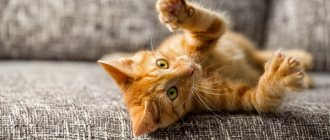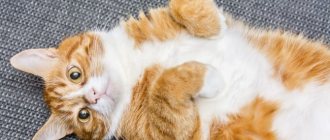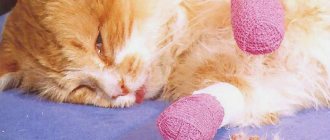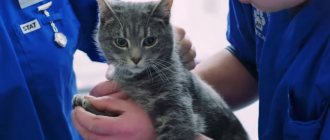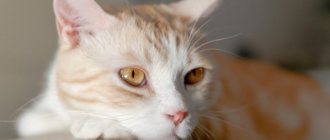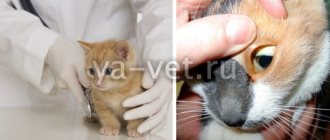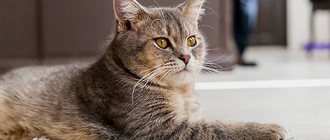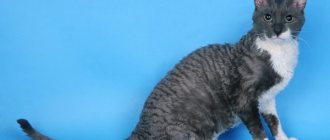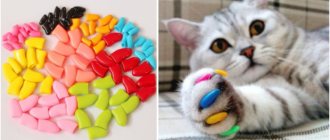- Cats
Some owners of cats and cats, in order to keep the interior of their home safe and sound, to protect family members, especially children, from the threat of being scratched, decide on a rather complex operation - declawing cats, which is called onychectomy.
At what age can a cat be declawed?
Owners who are thinking about having a cat declawing operation are concerned about the question of when they can start the procedure. But before taking such extreme measures for cats who have the opportunity to walk, take into account that the animal will remain defenseless.
A kitten should not have its claws removed: their soft scratches do not cause harm; the body continues to form. In addition, it is absolutely cruel to subject a child to such stress.
According to the veterinarian’s recommendations, declawing surgery is performed on a kitten no earlier than 6-7 months. But it would be better to do it within a period of eight months to a year: the cardiovascular system has already become stronger, and the cat will have to get used to the consequences of walking without claws and adapt again in life situations. Therefore, if the owner has already decided to take such measures, then there is no need to delay and wait - in the absence of serious medical contraindications, the operation is easier to tolerate at a young age.
Alternative Methods
Using anti-scratch paws
Anti-scratch - the simplest and most reliable method
One of the alternative methods is to use anti-scratch agents. These are special silicone caps made of soft plastic material. They have a number of advantages. The cat gets the opportunity to freely release and sharpen its claws, because it retains the instinctive need for this even with anti-scratch protection. But the pet will not harm clothes or furniture. Also, the cat will not be able to scratch the owner. This nuance is especially relevant if there are small children in the house.
The caps do not cause any discomfort to the animal. A cat can lead a full life and not change its habits. Anti-scratch products will not cause harm to health, even if the pet swallows them. Special medical glue is used to fix it on the claw. On sale you can find anti-scratch caps of various sizes, which will allow you to choose caps for both an adult and a kitten.
Anti-scratch guards are put on as follows:
- First, the cat needs to be picked up and stroked so that it does not worry when its paws are manipulated.
- Apply a small amount of glue inside the cap, lightly press on the foot pad so that the claws come out, and put on the anti-scratch guards.
- Press down on both sides and hold for 1-2 minutes. This will help keep the cap firmly in place. Apply anti-scratch guards to the remaining claws in the same way.
It is recommended to start using caps when the kitten is six months old. Previously this was not necessary. A small kitten's claws are very soft, so he won't be able to cause any harm with them. Older cats, who no longer feel the need for the point of their claws as they become fragile, also do not need anti-scratch guards.
Video: master class on putting on anti-scratch boots
Nail trimming
Nail trimming is an equally practical alternative.
Another alternative method is trimming the nails. The procedure is carried out once every 10 days using special tweezers. Each claw is trimmed to 1 mm. Do not exceed this level, otherwise you may damage the sensitive area. This will cause pain and bleeding in the cat. Place the tweezers perpendicular to the claw. After trimming, praise your cat so that she develops a positive attitude towards the procedure. It is better to accustom an animal to pruning from childhood.
Important! Do not use regular scissors for trimming, as they may damage the nails.
Video: cutting master class
Advantages and disadvantages of declawing cats
global $ads_google;
//data-ad-slot=”2475549904″ $ads_google = empty($ads_google) ? false : true; ?> if ($ads_google == false) {?> $ads_google = true; ?> } ?> It doesn't take long to remove a cat's claws. But are there any advantages from this? Yes, I have. This is the impossibility of damaging furniture and the absence of scratches on the skin of household members.
But the disadvantages include a number of points:
- anesthesia is not just a dream, but stress for the body;
- the animal is in great pain for a very long time after the operation. The pain is dulled with various painkillers, which is also considered an intervention in the body;
- the phalanx may grow back and require repeated surgery;
- This is real stress for a cat, which not every animal experiences without consequences.
- a cat without claws is defenseless, and any trip outside can end in disaster;
- as a result of onychectomy and a feeling of vulnerability, the pet may use its teeth;
- the pet’s character changes, it may become withdrawn;
- Difficulties with the toilet: sometimes cats refuse to go to the litter box due to the inability to rake;
- the animal will never step on the entire foot completely again in its life, which affects its gait.
Therefore, maybe it’s worth thinking about other options for protecting furniture from cat scratches?
Postoperative care
After the operation, the animal is put on a collar, which will help avoid licking the stitches.
Typically, recovery after surgery takes about 1 month. During this period, pet owners will need to clean the stitches every day with an antiseptic solution prescribed by a veterinarian. The cat needs to be put on a special collar, which is attached to the neck and prevents it from licking the seams. The animal will need to wear a collar until they are removed. Mostly, stitches are removed 2 weeks after the “soft paws” operation.
To reduce the likelihood of infection in the body, the veterinarian prescribes antibacterial medications. It is not recommended to use regular toilet filler. Veterinary doctors from the Zoovet clinic advise placing torn paper in the tray. In addition, the owner will need to carefully care for the cat until it adapts to new living conditions. Care and attention and playing with your pet will help reduce stress from the procedure.
Description of declawing surgery
Onychectomy is banned in a number of European countries.
Local anesthesia is sometimes used for the operation, but general anesthesia is more often used.
The claws are removed entirely from the first phalanx of the finger. A suture and anesthetic ointment are applied to the damaged area. Then the paw is bandaged, and a collar is put on the cat’s neck, which will protect the seams from licking.
Along with the application of anesthetic ointment, auxiliary injections are administered.
How is the procedure performed?
“Soft paws” is not just the removal of the cat’s claws as such, but their removal along with the terminal phalanges of the fingers. It is performed under combined anesthesia, when general anesthesia and local anesthesia are used simultaneously. The procedure itself takes about 30-40 minutes, during which the claws are carefully removed using surgical instruments, and sutures are placed at the incision sites.
Post-operative recovery takes about 3-4 weeks. at this time you need:
- daily treatment of seams with an antiseptic;
- a protective collar to prevent the cat from licking the stitches, which are removed after 7-14 days;
- antibiotic therapy as prescribed by a doctor to reduce the risk of infections;
- using silica gel or paper instead of cat litter.
In addition, the cat needs close attention and care from the owner while it gets used to new living conditions.
Consequences of deletion
After the operation, the following consequences may appear:
- soft tissues after such an injury on the paws become inflamed, which is fraught with the onset of a necrotic process;
- Losing a large amount of blood during the declawing procedure complicates the healing process;
- impaired coordination of movements;
- difficulties associated with recovery from anesthesia.
Before the operation, consult a doctor at the clinic and identify the presence of serious medical indications: sometimes the cat actually needs to have 1-2 claws removed. In any case, first assess all the risks, and then begin the procedure.
Contraindications and consequences for cats
One of the main contraindications to the manipulation is to take the cat outside for walks, as the cat may be injured after the procedure.
Surgical intervention is not resorted to in situations where the pet leads a street lifestyle. As for postoperative complications, the intervention can cause stress in the cat. Animals feel defenseless, so changes in their behavior are often observed. Pets may prefer to be alone, avoiding contact with their owners. The opposite situation can also happen when the cat becomes aggressive and lets in a second weapon - teeth.
In addition, anesthesia, even gentle, does not benefit the body of pets, but vice versa. The animal leaves him for about a day. The rehabilitation period does not always go well; sometimes the animal experiences pain for a long time while walking. The possibility of wound infection cannot be ruled out. This is especially true in situations where the operated paw was not bandaged or the owner does not follow the recommendations for postoperative care.
There are cases of changes in gait, as well as loss of coordination of movements. These complications are caused by a decrease in the support area. After surgery, the cat is forced to step on its feet instead of its toes. Diseases of the musculoskeletal system can also develop. After soft paw surgery, the load may be unevenly distributed, which is why curvature of the spinal column or osteomyelitis sometimes develops.
Rehabilitation of cats after onychectomy
When the cat's claws are removed, the process of recovery after surgery begins, both for the condition of the paws and for the entire body. Fluffy needs the caring attitude of the owner.
There are a number of nuances for caring for a cat:
- pain relief in the form of injections, if necessary;
- daily treatment of wounds;
- the dressing needs to be changed regularly;
- A visit to the doctor is recommended once a week
.
The cat is really looking forward to its owner's love and care, only in this case it will get better sooner.
The recovery period after surgery lasts a month. During the first few days it is painful for the cat to stand on its paws; it will be hampered by pain and discomfort. Then the walking process gradually improves, but the cat may limp.
It is better to remove the cat's claws first on the front paws and then on the back paws. One by one deletion is allowed. This requires expert advice.
Cost of declawing
global $ads_google;
//data-ad-slot=”2475549904″ $ads_google = empty($ads_google) ? false : true; ?> if ($ads_google == false) {?> $ads_google = true; ?> } ?> If we take into account the price of declawing a cat within the central district of Russia, then the total cost can range from 1,500 to 5,000 rubles. The status of the clinic, the skill of the doctor, and the distance from the city center play a role.
There are veterinarians who specialize in surgery, and they should be given preference.
If you call a doctor to remove a cat’s claws at home, the price will not increase much, and healing will be faster.
